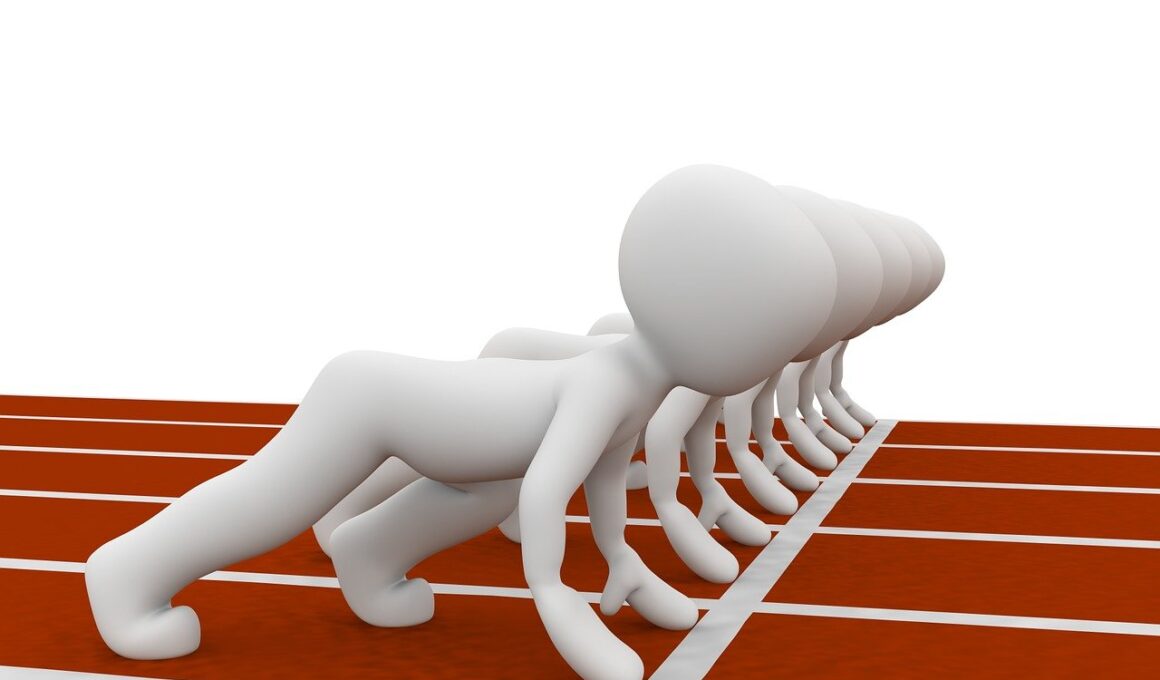How to Improve Your Running Cadence and Efficiency
Improving your running cadence and efficiency is vital for enhancing overall performance and preventing injuries. Cadence refers to the number of steps you take per minute while running. An optimal cadence typically falls between 170 and 180 strides per minute for most runners. To achieve this, focus on increasing your turnover rate. One effective method is to use a metronome or a cadence app that can provide a consistent beat for you to match your strides. This helps to develop muscle memory and encourages quicker footfalls. Additionally, incorporate interval training into your routine, alternating between fast intervals and recovery periods. This will condition your body to adapt to a faster pace. Stride length also plays a significant role in overall efficiency; try not to overreach when landing on your foot. Instead, aim for midfoot strikes to decrease the amount of energy wasted during each run. Conditioning your muscles through strength training can also be beneficial, helping to support better form and improve running economy. Always remember to listen to your body and adjust your training based on how you feel as you progress.
When working on your running form, consider the importance of posture in achieving improved cadence and efficiency. Good running posture enables you to breathe better and maintain energy throughout your run. Begin by keeping your head up, shoulders relaxed, and arms bent at about a 90-degree angle. Your arms should move forward and backward rather than across your body, which can interfere with your balance. Keep your hips stable and aligned with your shoulders, as this will contribute to maintaining a straight line while running. In addition, pay attention to your foot placement: aim to land your feet directly beneath your body instead of in front of you. Visualize a line running down the center of your body; your feet should ideally land close to this line to improve your efficiency. Breathing techniques are also essential. Practice diaphragmatic breathing, inhaling through your nose and exhaling through your mouth. This method allows for better oxygen intake. Combine these techniques with regular practice, and you will notice improvements in your cadence. Don’t forget to implement rest days in your training schedule for optimal recovery.
Incorporating Drills into Your Routine
To further enhance your running cadence, incorporating specific drills can be instrumental in developing muscle strength, flexibility, and overall technique. High-knees and butt kicks are efficient running drills aimed at increasing your turnover. Perform high-knees by driving your knees towards your chest while maintaining an upright posture. Aiming for a quick pace, take short and powerful steps, which improves your ability to lift your knees while promoting a faster cadence. Butt kicks, on the other hand, require you to kick your heels towards your glutes as you run. These power moves also promote elasticity in your hamstrings. Another effective drill is the “fast feet” exercise where you stand in one spot and rapidly tap your feet on the ground for a short duration. This rapid stomping motion develops speed and coordination. Adding sprinting intervals with an emphasis on short bursts of speed can also be incredibly beneficial. Aim for 20-30 seconds of fast running followed by a recovery period. Performing these drills and intervals consistently can contribute significantly to achieving better cadence while fostering improved speed,
and efficiency in your running. Instead of focusing solely on distance, dedicate some training sessions specifically for cadence improvement. One method to gauge your progress while aiming for higher strides is recording your runs and analyzing your cadence data using running apps or smartwatches. These tools help track both your cadence and pace during your runs. Continually monitoring your performance will provide insight on when to push harder or adjust your training. You can also consider running on a softer surface, such as grass or a synthetic track, which can reduce the impact on your legs and enables a more consistent stride frequency. Progressively increase your running time on softer surfaces as you adapt. To gain valuable feedback, join a local running group or club where members can offer support and advice. Engaging with a community not only makes running more enjoyable but also fosters motivation to improve. Leverage online platforms, such as social media or forums, where runners exchange their experiences and tips. Overall, by incorporating these strategies, you will gradually notice significant strides in both cadence and overall running efficiency.
The Role of Nutrition and Recovery
Nutrition plays a critical role in enhancing your running performance. A balanced diet fuels your body with the energy needed to support increased training loads and ultimately improve your running efficiency. Prioritize carbohydrates to provide the necessary energy reserves, while protein aids muscle recovery and growth. Consider complex carbohydrates such as quinoa, brown rice, and sweet potatoes. Incorporating a variety of fresh vegetables can ensure that you receive essential vitamins and minerals. Moreover, remain hydrated before, during, and after each run for optimal performance. Dehydration can lead to fatigue, negatively impacting both your cadence and efficiency. Consuming electrolytes during long runs can also support hydration levels. In addition to nutrition, recovery times allow your muscles to repair, adapt, and strengthen. Ensure you schedule proper post-run stretches and consider foam rolling or massage therapy to alleviate soreness. Active recovery days can be beneficial; partake in low-impact activities such as cycling or swimming. Monitoring sleep quality is equally crucial as rest promotes optimal recovery; aim for at least seven to nine hours of quality sleep each night to rejuvenate your body.
Maintaining motivation is essential while working on improving your running cadence and efficiency. To stay engaged, set achievable, measurable goals that inspire you to keep pushing forward. Short-term goals can be weekly or monthly milestones focused on increasing your cadence or running distance. Use a running journal to track your progress and celebrate your accomplishments. In contrast, long-term goals can be more ambitious, such as completing a specific race or achieving a particular finish time on a course. Additionally, participate in local races or running events to challenge yourself and put your training to the test. These events create a sense of community that often provides the extra encouragement you may need. As you focus on these goals, consider rewarding yourself when you achieve them, as this can create positive reinforcement. In addition to participating in races, engaging in social media platforms can forge connections with fellow runners. Share your journey, ask for advice, and exchange experiences to foster a supportive atmosphere. Remaining connected helps maintain enthusiasm and commitment to improving your running capabilities.
Conclusion: Faith in Your Progress
Finally, remember that improvement in running cadence and efficiency takes time, patience, and consistency. Embrace the journey and allow yourself to progress at a pace that feels comfortable. Everyone experiences setbacks, but persistence will yield results over time. Regularly remind yourself of your goals and strive to remain positive in your development. Celebrate small victories and milestones as they serve as motivation to keep pressing on even when progress seems slow. You might consider joining a running club or seeking out a running buddy for added accountability and motivation. Sharing your aspirations with others will bolster your determination to stay the course. Lastly, trust the process; over time, you will notice improvements in your running cadence and overall efficiency. Adjust your training strategies as needed to cater to your individual capabilities, allowing for personal growth. Whether you’re a beginner or an experienced athlete, honing these skills supports your journey toward becoming a more efficient runner. As you actively internalize these practices, you will gradually master the art of running with improved cadence while reveling in the exhilaration of your achievements.


